Introducing the ‘Models of Authority’ Project: Scottish charters c.1100–c.1250
Feature Article 1: Dauvit Broun
The project aims through the study of charters to offer a new perspective on a fundamental historical development: the origins of government in western Europe. Tim Reuter described this deftly when he observed that, ‘By around 1200 we have begun to move towards a world in which political interaction was no longer confined to assemblies: governments were increasingly governing continuously rather than in brief spurts’.[1] Writing was at the heart of this process. Part of the background was the growing importance of charters during the twelfth century as a means of representing and regulating social interactions, particularly in relation to property-rights. In turn, royal authority became increasingly relevant to this core concern of charters from the late twelfth century. It might be expected, therefore, that developments in the production of charters would bear some relationship to the changing nature of government. The problem lies in how to identify and investigate this.
This project is an attempt to rise to this challenge through not only the tried and tested methods of analysing charters but also through the development of a new digital resource. John Reuben Davies is currently analysing the diplomatic of royal charters, showing how they developed and what made them distinctive. This will lead ultimately to an assessment of how far non-royal charters show an awareness of royal charters through imitating particular features or studiously avoiding others. Tessa Webber is developing an approach to the palaeography of the charters that will enable aspects of style to be identified, and how and when these emerged. This will make it possible, in turn, to investigate of how far royal charters served as a model for scribes of non-royal charters. Alice Taylor, in a forthcoming Feature of the Month, will highlight how diplomatic and palaeography can be combined to illuminate our understanding of government. The work in these traditional disciplines is, however, not only an end in itself in the project but also provides a platform for the new digital resource that is being developed. This builds on the experience of the DigiPal project masterminded by Peter Stokes, Stewart Brookes and Geoffroy Nöel. Not only will this enable the analysis of the diplomatic and palaeography across the corpus to reach new levels of precision and sophistication, especially when both aspects are combined, but it will also allow anyone with access to the web to analyse the palaeography and diplomatic of the charters for themselves.
What all of these dimensions of the project have in common is a focus on charters that survive as ‘originals’—that is, as contemporary single sheets. The great majority of charters, however, survive in cartularies. When the project was first conceived it was assumed that a fine-grained analysis of scribal approaches to charters would of necessity be confined to originals. This is no longer the case. Joanna Tucker has developed a new approach to studying the earliest Scottish cartularies which has the potential to open the door to fresh perspectives on documentary culture in this period.
All of this is focused on Scotland. Taking the twelfth and thirteenth centuries as a whole, about 5,000 Scottish charters as such survive (including brieves), of which over a fifth are extant as contemporary single sheets. In this introduction to the project I will attempt to explain why Scotland makes a good test case for developing a new charter-based perspective on the emergence of ‘continuous government’ in Reuter’s sense. The reasons are both pragmatic and historical. I will begin, however, with some background on Scotland in this period and its charters in particular.
* * *
Look at a textbook of this period and you would not be surprised to find a map in which the Scottish kingdom is referred to simply as ‘Scotland’.
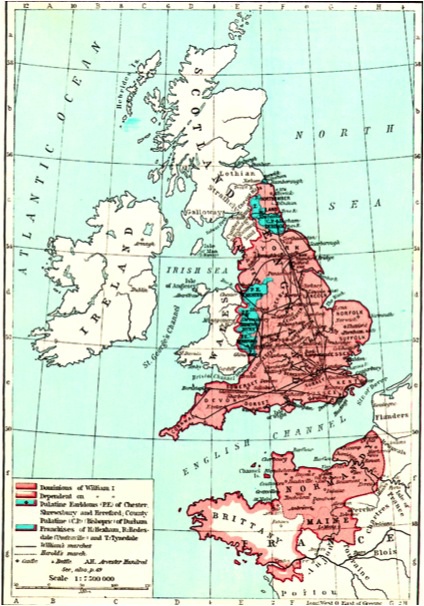
It appears, however, that it was only during the thirteenth century that kingdom and country were regularly thought of by its inhabitants as one-and-the-same. In the twelfth century, ‘Scotland’ did not denote the kingdom as a whole, but typically only the historic core between the Firth of Forth and River Forth, the River Spey and the mountain-range known as Drumalban.

The kingdom itself was thought of as a realm comprising a number of ‘countries’, as it were, with (in some cases) a clear sense of their own laws and customs. Some of these ‘countries’ had their own kings in the early twelfth century, while others had been regularly under the control of kings of Scots for at least a couple of generations. The history of this period is not simply about territorial expansion, however. The radical change of the kingdom from a realm of many countries to a single country and people highlights the growing significance of royal government as a focus of identity.[2]
The first traces of this new identity can be picked up in charters where property is said to be held or given as freely as any other similar property is held or given in the kingdom of Scotland or the kingdom of the Scots (in regno Scotie or in regno Scottorum). This implies an assumption that property-rights were the same across the kingdom, and were enjoyed on the same terms. The earliest example of the kingdom as a point of reference like this in a charter dates from the 1150s. It only ceased to be a rarity, however, from the 1180s at the earliest.[3]At this stage charters had only recently become a regular part of property transactions at the apex of society: Matthew Hammond has recently argued compellingly that royal gifts of land to lay people were routinely recorded in a charter from the mid-1160s.[4]
* * *
Charters themselves were a relatively recent phenomenon in Scotland. The very earliest examples date from the 1090s, and are restricted to royal charters. All these were produced by Durham Cathedral Priory. The earliest extant original charter written in Scotland is a brieve of Alexander I.[5] Although we must always be alert to the problem that many more charters have been lost than survive, there is nothing about the prose, form or appearance of the earliest examples that cannot comfortably be explained as the result of recent introduction from England.[6] This is not to say that there were no property records of any kind in Scotland before the 1090s. A crucial distinction, however, can be made between the project’s charters and the material written into originally blank spaces in a pocket gospel book at Deer in the North-East.[7]
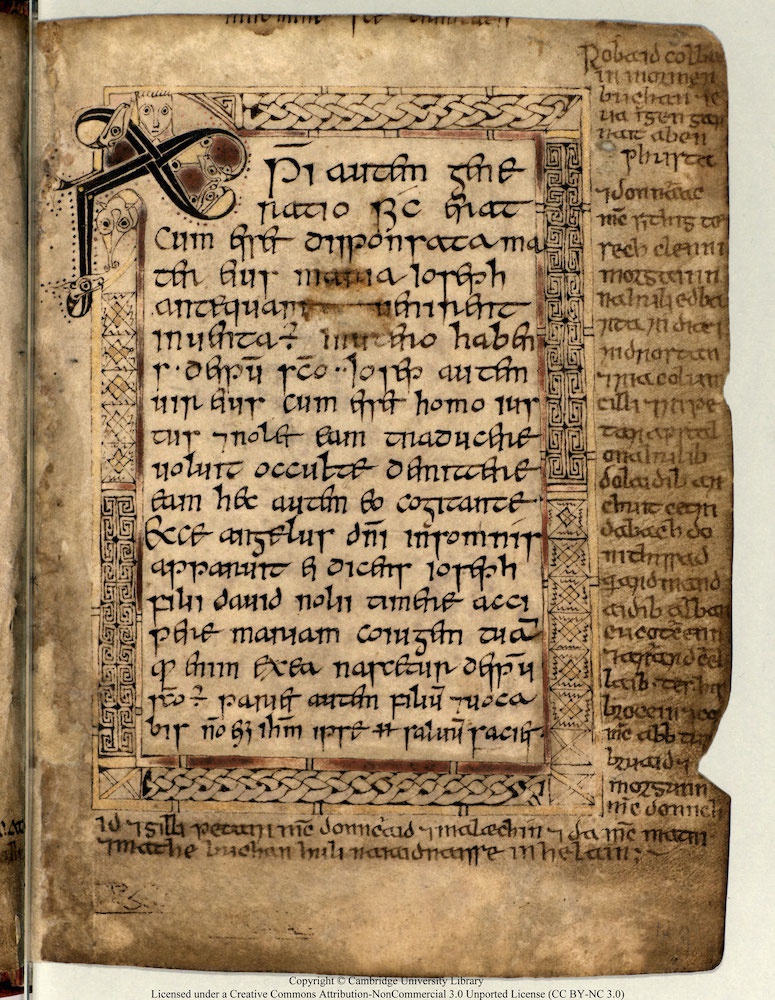
The protective force of a property-record in the Book of Deer (Cambridge University Library MS Ii.6.32) would have been enhanced by being written into the gospel book, either as a copy or as fresh prose. As far as charters are concerned, however, their full force was as a single sheet with the donor’s seal. They must have originated as such, even if most survive only as copies. The Deer records, by contrast, need not have existed as single sheets at all.[8]
The earliest generations of Scottish charters were based on English models, and exhibit similar prose and modified bookhand. On our current understanding, it would appear that this close association with England continued throughout our period. This means that any development has to be considered within a British context. It is likely, for example, that many, if not all the features that Tessa Webber has identified in her study of English charters during the course of the twelfth century will also be found in the project’s corpus.[9] Some charters also began to exhibit a few features derived ultimately from papal documents. If these were copied directly from bulls dispatched to Scotland—and this is by no means necessary—then the models might have been those which, like charters, were concerned with safeguarding possessions and privileges. Bulls like these began to be sought and received from the 1140s.[10]
* * *
This brings us to a particular reason why Scottish charters are a promising test case for exploring the emergence of ‘continuous government’. The key is the link between royal government and the development of cursivity. One external model for Scottish charters which there can be no doubt about is the chancery of the king of England.
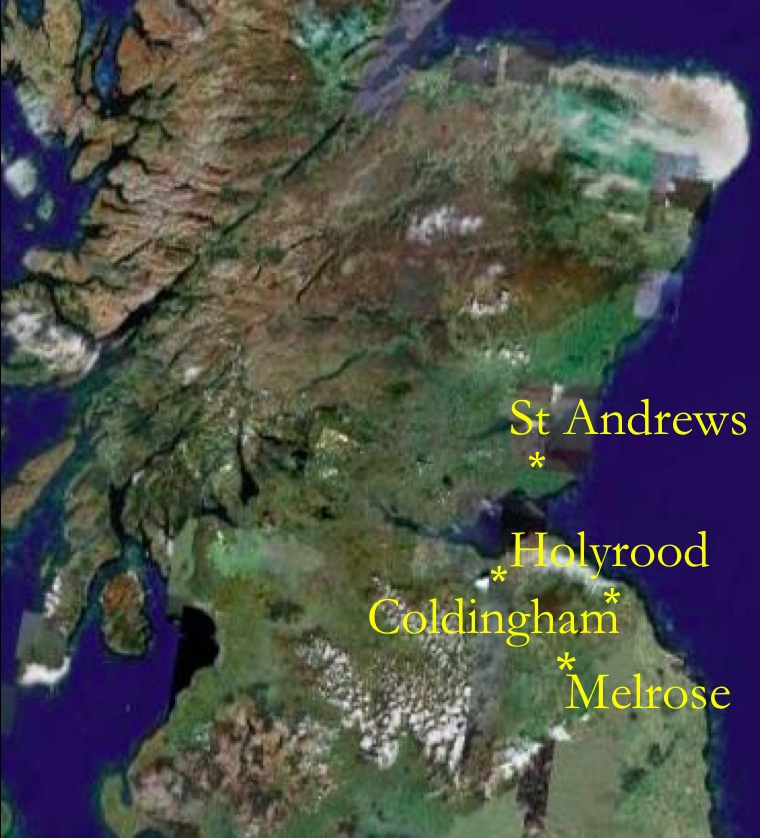
The earliest extant charter of David I, probably produced immediately after his inauguration as king in April 1124, looks just like a charter of Henry I of England (1100–1135).[11] Of course, not all royal charters shared this rapid or current style of handwriting. The fact, however, that during the twelfth century so many did is potentially of wider significance. T. A. M. Bishop, in his study of English royal scribes in this period, famously attributed the emergence of this hurried writing to ‘a common pressure of urgent official business’.[12] In this way, for purely pragmatic reasons, informality came to be introduced into the repertoire of writing for public purposes.
It is much more difficult, however, to explain the hurried handwriting in Scottish royal charters as arising from a similar need to produce documents rapidly. Scottish kingship was an intimate affair. Its writing office was always referred to as the king’s chapel rather than chancery. Alice Taylor has shown that bureaucratic procedures, such as the keeping of central copies of charters and other documents, only began to be developed in the mid-thirteenth century, towards the end of the period covered by the project.[13] In the case of the financial accounts returned by sheriffs, the central record was not, as in England, created as part of an audit, but were simply copies of what the sheriff had submitted every few years when the king or his chamberlain had been in the vicinity.[14] Even if there were only a couple of clerks in the twelfth century, I find it hard to imagine how they could have faced a daily grind of document production. This is not to say that there was never a need for speed. Geoffrey Barrow pointed out a charter that has been written in such haste that it was folded before the ink was dry.[15]
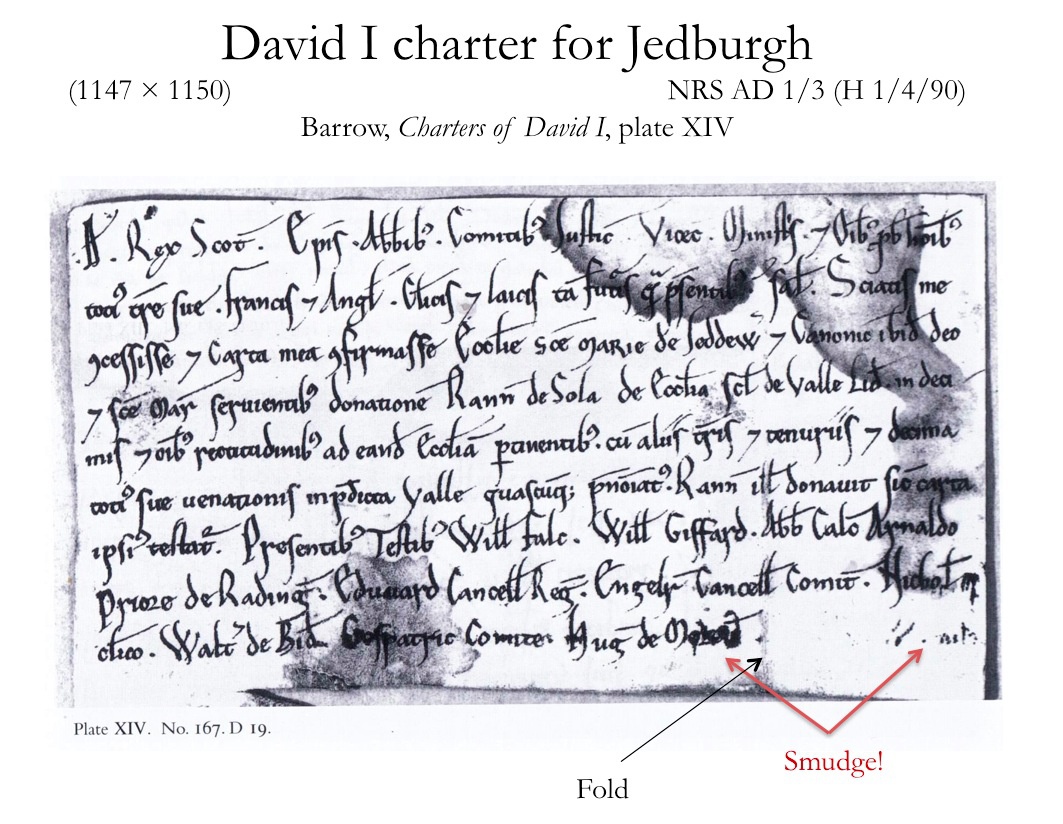
It seems more likely, however, that this was a one-off, showing inexperience—an indication that speedy production was uncommon, not the reverse.
As things stand, therefore, I would argue that the ‘look’ of English royal charters was imitated precisely so that the charters of a king of Scots would have the same caché as an English royal charter, in a roughly similar way as the design of Scottish silver pennies mimicked their English counterparts.[16]
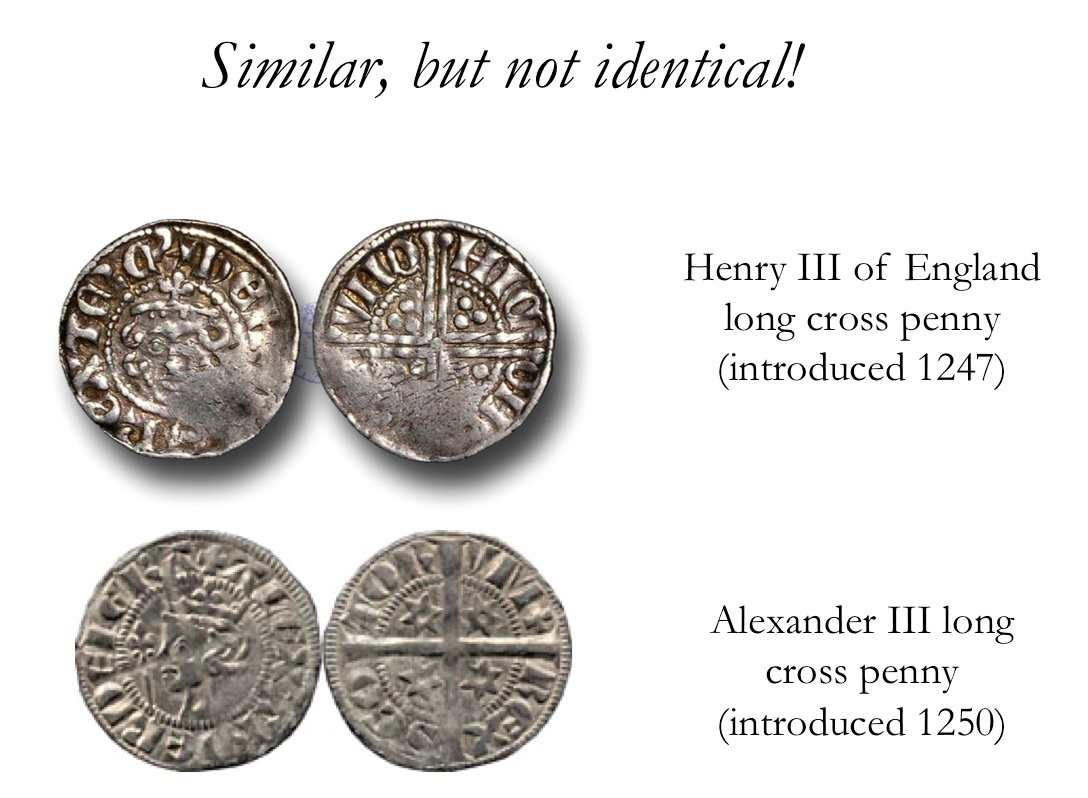
If so, the ultimate model of royal authority in Scottish charters generally could have been the English chancery mediated through the Scottish royal chapel. When this hurried writing evolved in Scotland (as in England) into a regular cursive script, this, too, is likely to have been for presentational reasons as much as, or more so, than for pragmatic ones.
Looking at Scottish charters overall, then, the royal and (in particular) non-royal charters of Scotland offer potential because of the variety in their appearance and content. Those who produced charters evidently had a degree of choice in adapting and combining a range of models.
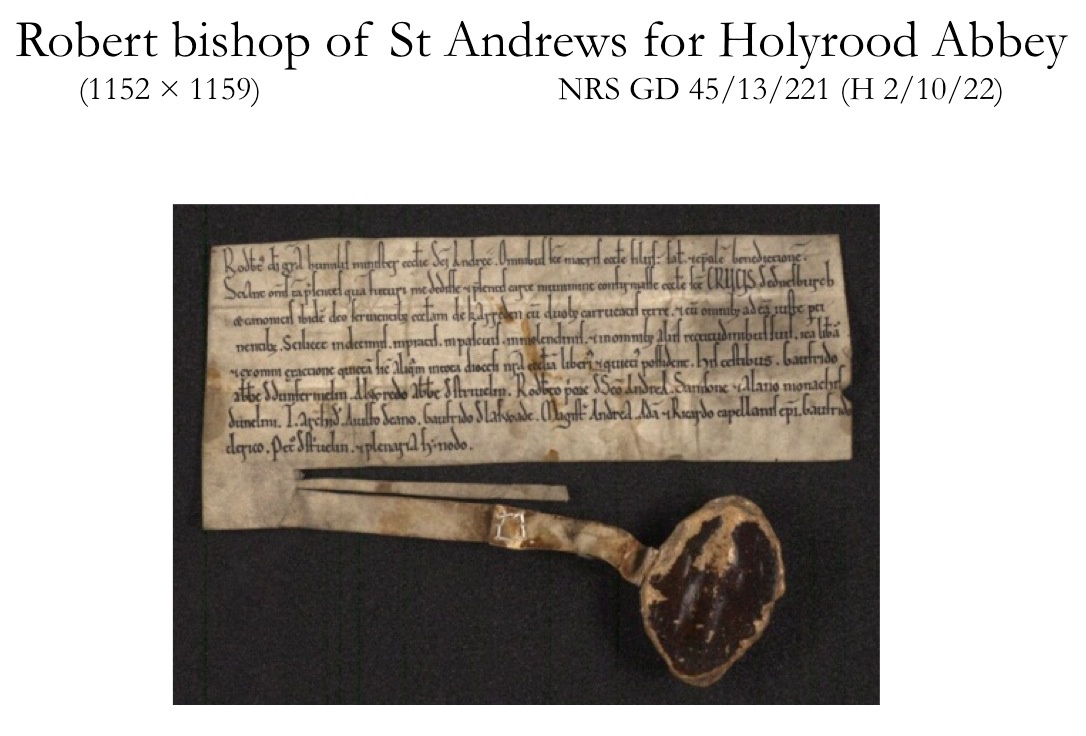
This included modified bookhand, as well as features derived ultimately from papal documents.
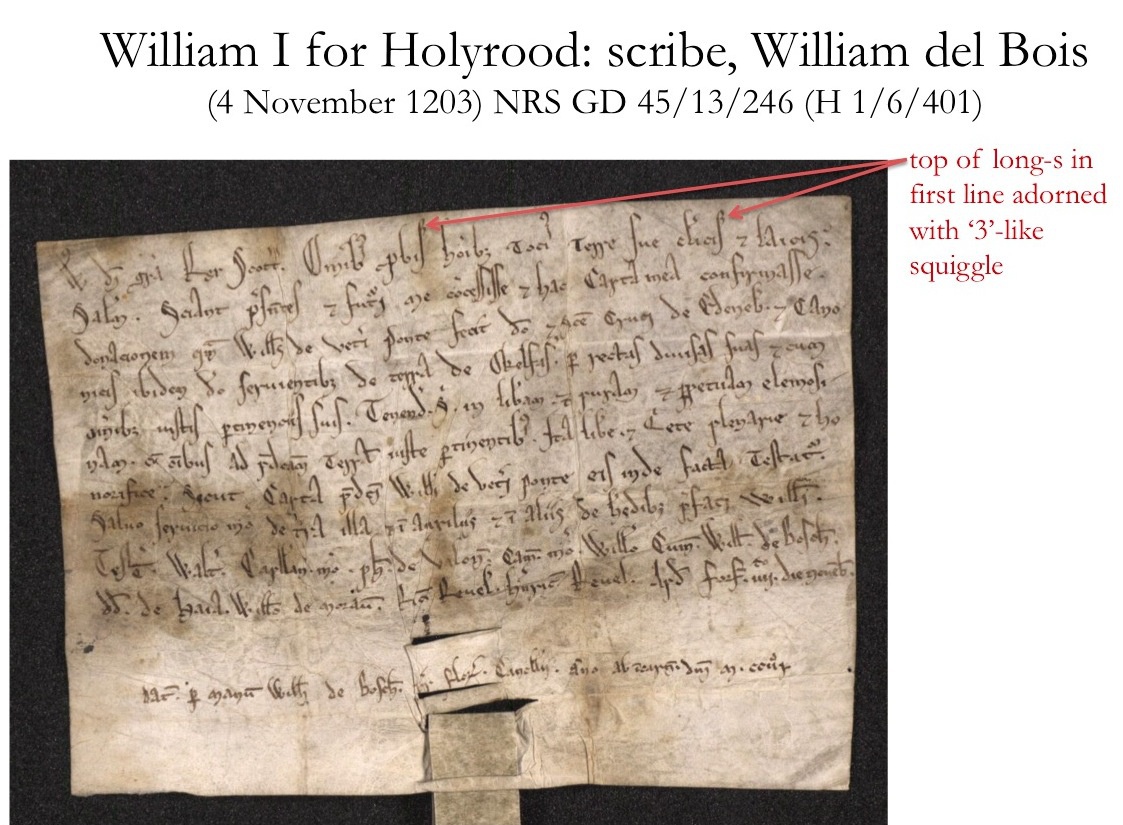
The most striking development in this period is the emergence of cursive writing in the formal context of charters. In Scotland it is much more likely that this was motivated not by pressure of business but because its appearance was deemed to be appropriate or desirable. This provides a special opportunity to investigate cursivity as potentially one of a variety of attributes that a charter could be endowed with in order to enhance its authority. Some attributes would, of course, have required more specialist skill than others. The only evidence we have for scribal training is the charters themselves. It may be guessed that those aspects which required most training are likely to have been the most highly prized.
There are also pragmatic reasons why Scotland is especially useful as a case study for developing a new charter-based approach to the emergence of ‘continuous government’. Essential information about all its charters in the twelfth and thirteenth centuries has recently been researched and made available in a bespoke database—essential information such as dating each text and identifying the people and places involved.
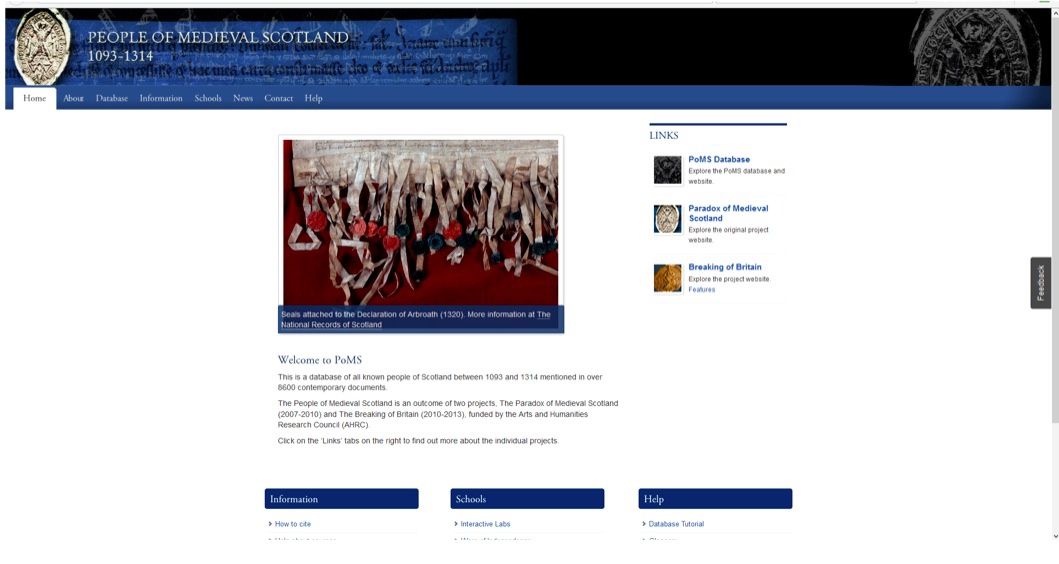
This database—called the ‘People of Medieval Scotland’ because of its primary concern for using charters as a source for social relationships—was developed between 2007 and 2012 with AHRC funding by John Bradley and Michele Pasin at King’s College London working with Matthew Hammond and others at the University of Glasgow.[17] It uniquely allows a kingdom to be viewed through all its charters in the critical period for the emergence of ‘continuous government’.
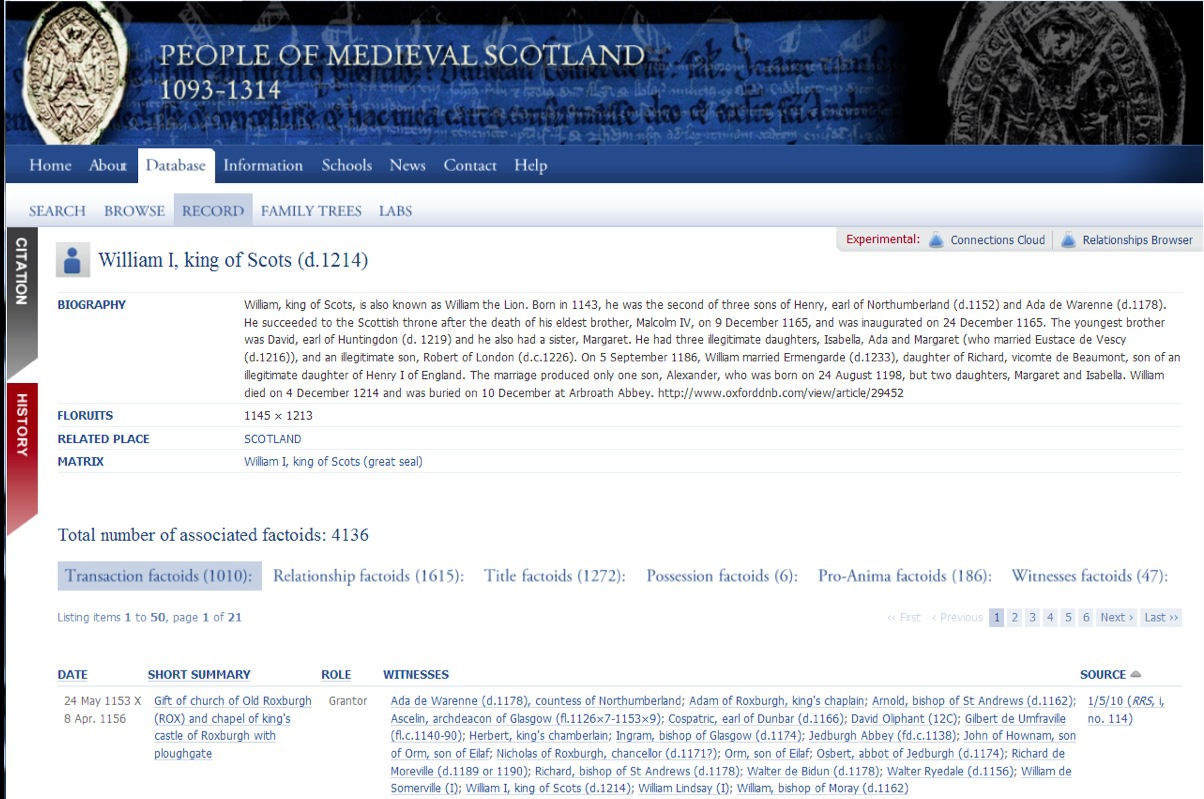
* * *
How, then, are we tackling the challenge not only of researching the diplomatic and palaeography of the charters but relating this to the broader theme of the emergence of government? The project focuses on the essentially imitative character of charters, and the capacity of scribes to innovate. As far as handwriting is concerned, there was considerable variation throughout this period between forms of bookhand on the one hand and the more current and eventually cursive writing that emerged in documents. The spectrum of possibilities was constantly evolving. There was also a spectrum of possibilities in the formal prose of charters. In broad terms this changed from a couple of types of charter within which there was considerable variety, to a wider array of forms of document in which the prose was more settled and predictable. As a result, a scribe would have had less freedom of movement. The project’s intention is to use a study of patterns of innovation and imitation to examine which models were influential in the handwriting and prose of Scottish charters between 1100 and 1250. It will also be significant to see if there were elements of the diplomatic and appearance that were regarded as exclusively royal or non-royal, suggesting a general awareness of what made a charter distinctively royal.
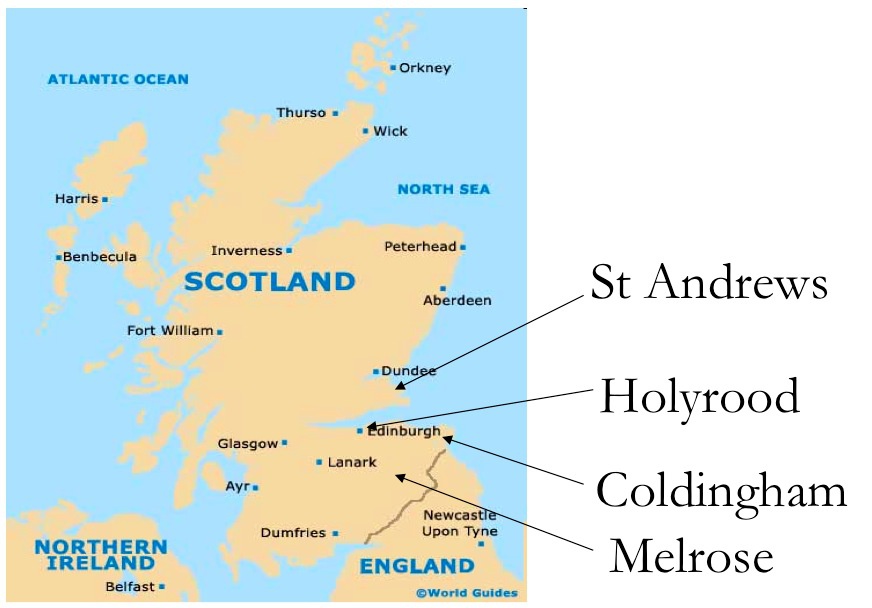
Because we are interested in both the handwriting and prose of charters, the project’s chief focus is on charters that survive as contemporary single sheets. A collection of 668 digital images has been assembled, with particular attention to the extant archives of two royal monasteries—the Augustinian Holyrood Abbey and Cistercian Melrose Abbey—as well as the Cathedral Priory of St Andrews, and the Scottish charters of Durham Cathedral Priory: almost all these Durham charters relate to its cell at Coldingham in the Scottish kingdom. The corpus of 668 images represents nearly 70% of all original charters relating to Scotland before 1250, and includes 43% of all royal original charters. The corpus itself consists chiefly of non-royal charters. It would have been wonderful, of course, to have had all 948 extant originals from this period to work on, but this was never going to be possible: for example, the 40 originals from the archive of Inchaffray Abbey are inaccessible. Overall, the corpus is small enough to be manageable but large enough for the results to be significant. The digital images will come into their own in the new research tool that is being developed by the project as a freely available web resource. This will provide the means to investigate the prose and especially the handwriting of charters as never before. The tools developed in the DigiPal project will be adapted in the fundamentally different environment of charters where letter-forms are inherently less stable and linked to other letters.
* * *
Our ultimate goal, of course, is to investigate how far kingship can be detected as a model of authority in the writing of Scottish charters, and how this relates to the emergence in Scotland of continuous government in Timothy Reuter’s sense. A particular advantage of focusing on Scotland is that Alice Taylor has recently completed her seminal work The Shape of the State in Medieval Scotland, 1124–1290, due to be published in March 2016. This will make it possible to correlate her account of the emergence of government with the results of the diplomatic and palaeographical analysis of the profile of kingship as a model for the prose and handwriting of non-royal charters. This has two dimensions. The first is to track developments in royal charters to see if there were ‘step changes’ in their palaeography and diplomatic and, if so, whether this anticipated or followed major innovations in royal government that Alice Taylor has identified. The second dimension is to investigate the influence of royal charters on non-royal charters. It will be interesting, for example, to see if this is more apparent in some charters than others, and how the chronology of any detectable use of royal charters as models might relate to developments in government. An example of a major innovation in the governance of Scotland that is likely to have had some impact on those who gave and received charters is the emergence in the early 1180s of a territorial jurisdiction for sheriffs in the kingdom’s historic heartlands.[18] Another example is the introduction in the early 1220s of a justiciar of ‘Scotland’, covering the area north of the Forth, and a justiciar of ‘Lothian’ covering the area south of the Forth.[19] These developments are likely to have been felt by those who were bound to attend the courts of sheriffs and justiciars—something which was defined in an assize of 1184.[20] Those within the jurisdiction of lords would not have been untouched, either. In 1180 it was established that barons, before holding their own courts, should inform the sheriff in order to give him (or a royal sergeand) the opportunity to attend.
We have not, of course, yet reached a point where we can report on our results. The core purpose of the project is to capture the complexity of charters, and only then think about the relationship between this and the emergence of continuous government. I would be disappointed if this was straightforward!
Notes
[1] T. Reuter, ‘Assembly politics in western Europe from the eighth to the twelfth century’, in Peter Linehan and Janet L. Nelson (eds), The Medieval World (London 2001), 432–50, at 433.
[2] Dauvit Broun, ‘Rethinking Scottish origins’, in Steve Boardman and Susan Foran (eds), Barbour’s Bruce and its Cultural Contexts. Politics, Chivalry and Literature in Late Medieval Scotland (Woodbridge 2015), 163–90.
[3] Dauvit Broun, ‘Britain and the beginning of Scotland’, Journal of the British Academy, 3 (2015), 107–37, at 111–14.
[4] Matthew Hammond, ‘The adoption and routinization of Scottish royal charter production for lay beneficiaries, 1124–1195’, in David Bates (ed.), Anglo-Norman Studies XXXVI, Proceedings of the Battle Conference 2013 (Woodbridge 2014), 91–115.
[5] Durham Cathedral Muniments Miscellaneous Charter 562 (1107 × 1124).
[6] Dauvit Broun, ‘The adoption of brieves in Scotland’, in Marie-Therese Flanagan and Judith A. Green (eds), Charters and Charter Scholarship in Britain and Ireland (London 2005), 164–83.
[7] Roibeard Ó Maolalaigh, ‘The property records: diplomatic edition including accents’, and Katherine Forsyth, Dauvit Broun and Thomas Clancy, ‘The property records: text and translation’, in Katherine Forsyth (ed.), Studies in the Book of Deer (Dublin 2008), 119–130, 131–44.
[8] This is a better way of encapsulating the distinction between charters and property records than in Dauvit Broun, The Charters of Gaelic Scotland and Ireland in the Early and Central Middle Ages. Quiggin Pamphlet no.2. Department of Anglo-Saxon, Norse, and Celtic, University of Cambridge (Cambridge 1995), and Dauvit Broun, ‘The writing of charters in Scotland and Ireland in the twelfth century’, in Karl Heidecker (ed.), Charters and the Use of the Written Word in Medieval Society, Utrecht Studies in Medieval Literacy no. 5 (Turnhout 2000), 113–32. It arises from Joanna Tucker’s work on cartularies, building on the relationship between originals and cartularies discussed in Laurent Morelle, ‘Histoire et archives vers l’an mil: une nouvelle “mutation”?’, Histoire et Archives, 3 (January–June 1998), 119–41, and Laurent Morelle, ‘De l’original á la copie. Remarques sur l’évaluation des transcriptions dans les cartulaires médiévaux’, in Olivier Guyotjeannin, Laurent Morelle and Michel Parisse (eds), Les cartularies. Actes de la table ronde organise par l’École nationale des chartes et le G.D.R 121 du C.N.R.S (Paris, 5–7 décembre 1991) (Paris 1993), 91–102. For an example of a record written directly into a gospel book, see English Historical Documents, vol. i, ed. Dorothy Whitelock (London 1955), 602, discussed in Elaine Treharne, ‘Textual communities (vernacular)’, in Julia Crick and Elisabeth van Houts (eds), A Social History of England, 900–1200 (Cambridge 2011), 341–51, at 347–8.
[9] Teresa Webber, ‘L’écriture des documents en Angleterre au XIIe siècle’, Bibliothèque de l’École des chartes, 165 (2007) [published 2008], 139–65.
[10] Robert Somerville, Scotia Pontificia. Papal Letters to Scotland before the Pontificate of Innocent III (Oxford 1988), nos. 23, 25–28.
[11] BL Cotton Charter xviii. 45; G. W. S. Barrow, The Charters of King David I. The Written Acts of David I King of Scots, 1124–53 and of his son Henry Earl of Northumberland, 1139–52 (Woodbridge 1999), no. 16. David I’s second chancellor, William Cumin, had earlier been in the household of Geoffrey Ruffus, bishop of Durham, who had in turn worked in Henry I’s scriptorium: G. W. S. Barrow, ‘The Scots charter’, in G. W. S. Barrow, Scotland and its Neighbours in the Middle Ages (London 1992), 91–104, at 102.
[12] T. A. M. Bishop, Scriptores Regis (Oxford 1961), 13. On the increasing numbers of English royal documents and development of English royal administration in the twelfth century see M. T. Clanchy, From Memory to Written Record. England 1066–1307, 3rd edn (Chichester 2013), 58–75.
[13] Alice Taylor, The Shape of the State in Medieval Scotland 1124–1290 (Oxford 2016), chapter 7. It is due to be published in March: see http://ukcatalogue.oup.com/product/9780198749202.do to order a copy!
[14] Taylor, The Shape of the State in Medieval Scotland, chapter 6.
[15] Barrow, The Charters of King David I, no. 167 and Plate XIV.
[16] For example, the long cross pennies introduced in 1250, modelled closely on the English long cross penny of 1247 (except that the king’s head is in profile rather than facing): J. D. Bateson, Coinage in Scotland (London 1997), 44.
[17] Amanda Beam, John Bradley, Dauvit Broun, John Reuben Davies, Matthew Hammond, Michele Pasin with David Carpenter, Roibeard Ó Maolalaigh and Keith J. Stringer, and the assistance of Susan Bell, Kathryn Dutton, Nicholas Evans, Beth Hartland, Fergus Oakes and Andrew Smith, The People of Medieval Scotland, 1093–1314 (Glasgow and London 2012): www.poms.ac.uk.
[18] Taylor, The Shape of the State in Medieval Scotland, chapter 4; Alice Taylor, ‘Leges Scocie and the lawcodes of David I, William the Lion, and Alexander II’, Scottish Historical Review, 88 (2009), 207–88, at 270–1, 284.
[19] Taylor, The Shape of the State in Medieval Scotland, chapter 4.
[20] Taylor, The Shape of the State in Medieval Scotland, chapter 4; Taylor, ‘Leges Scocie and the lawcodes of David I, William the Lion, and Alexander II’, 260–2, 282–3.
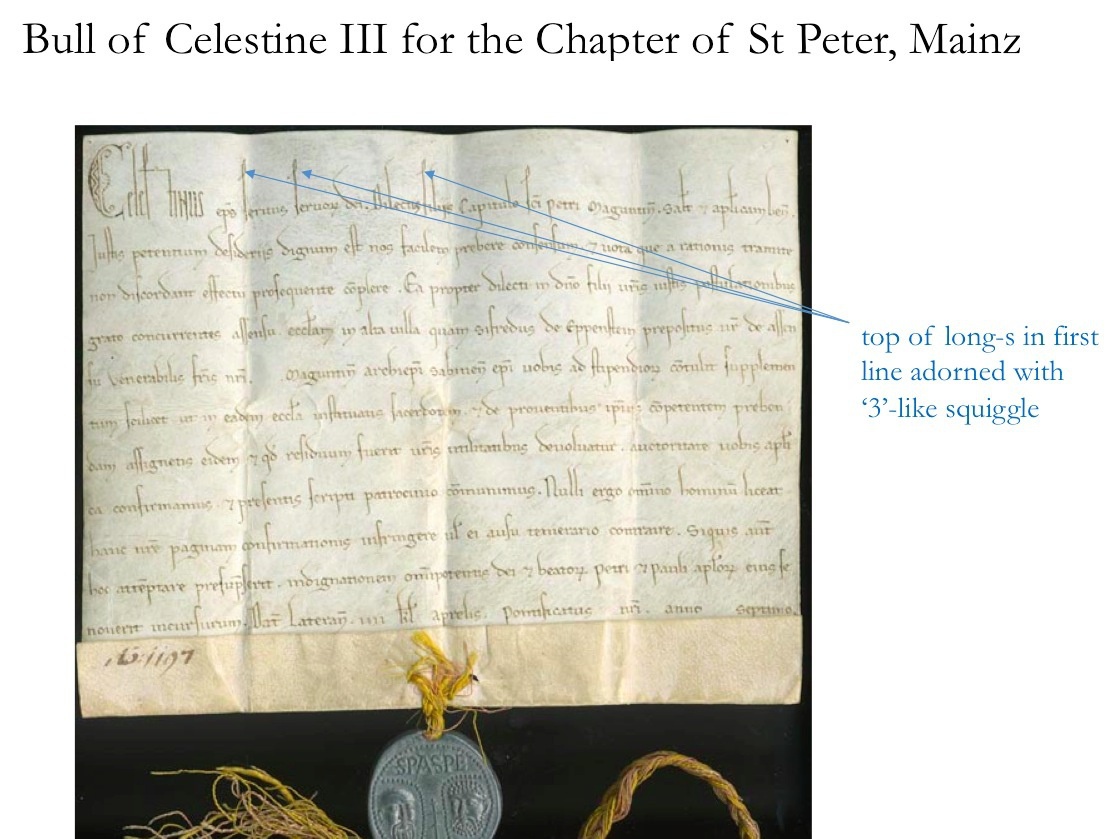
Comments